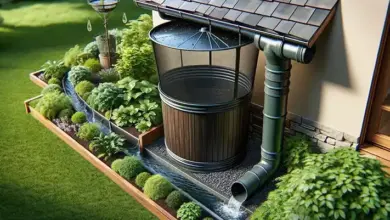How to Make Stinging Nettle Fertilizer Tea to Feed Plants
The strongest fertilizer and insecticide found in nature (easy to make) 💥💬👇
Do stinging nettles grow rampantly in your area? If so, you’re in luck. Because that means you have an abundance of free and fabulous fertilizer – right at your fingertips! Uh, gloved fingertips that is. Read along to learn about the benefits of stinging nettle, how to comfortably harvest it, and how to turn it into homemade fermented nettle fertilizer tea. The other plants in your garden will thrive in return!

What is Stinging Nettle?
Stinging nettle (Urtica dioica, also known as common nettle or nettle leaf) is an herbaceous perennial plant. It usually pops up each spring, and easily spreads after flowering and going to seed. Nettle is native to Europe but now grows in damp fertile soils virtually throughout the world. If you’re foraging for wild nettles, look in shady and moist locations like along creeks.
Stinging nettle is often considered a “weed” due to its promiscuous growth habits. It also catches a bad wrap as a bully (admittedly justified) by causing a painful itching and burning sensation to those who come in contact with the sharp hairs that cover its leaves. An inflammatory nettle rash is uncomfortable, but temporary and not dangerous. Furthermore, after reading about the stellar benefits of stinging nettle, perhaps you’ll realize that nettle can be even more of an asset than a nuisance!

Health benefits of stinging nettle
Herbalists, naturopaths, and many organic gardeners recognize stinging nettle as a favorable plant to have around – given its numerous and well-researched healing properties. Compounds found in nettle make it excellent at fighting bacterial infections, reducing inflammation and arthritis, relieving pain, easing allergy symptoms, stabilizing blood sugar levels , and more. In fact, this natural nettle quercetin is the only “allergy pill” I take – and I am quite sensitive to environmental allergens!
SUPPLIES NEEDED TO MAKE NETTLE FERTILIZER TEA
Stinging Nettle
Prick-proof gloves. Thick leather pruning gloves (or similar leather alternative) are especially protective against thorns and nettles.
Trimming shears or scissors
Water, preferably un-chlorinated – such as collected rain water. To dechlorinate city tap water, either allow it to sit out in the sun in a bucket for 24 hours to allow the chlorine to dissipate, or use a carbon hose filter.
Bucket with lid
Stir stick
A fine mesh strainer, cheesecloth, paint strainer bag, or nut milk bag.
INSTRUCTIONS
I will go ahead and air the dirty laundry now: fermented stinging nettle tea fertilizer stinks . Big time! So much so, that it’s sometimes referred to as “nettle manure”. Or as I like to call it: Stinking Nettle Tea. Therefore, I strongly suggest you make your stinging nettle fertilizer outside somewhere and not in your garage or house. Please don’t let the funky aroma dissuade you from making nettle tea! But don’t say I didn’t warn you.
Steps to Make Stinging Nettle Fertilizer Tea
- Collect nettle in a bucket . We typically loosely fill a 5-gallon bucket. To harvest stinging nettle, you can either pull it out by the roots (if you don’t want it to grow back this season) or use scissors/shears to trim it instead. Wear gloves to protect yourself!
- In the bucket, chop the nettle into smaller pieces. Finer pieces equals more surface area for fermentation and the release of nutrients.
- Add enough water to cover the nettle in the bucket. It should be able to stir freely and not be overly thick.
- Set the lid on top of the bucket, but don’t seal it.
- the brewing nettle tea once per day if possible. Bubbles should appear as you stir it.
- After one to two weeks , the nettle tea is finished brewing. A good signal that your fertilizer is ready is when it stops visibly bubbling after stirring. That means the nettle is no longer actively fermenting.
- Strain the nettle solids from the tea liquid. We do this by pouring the solution through a funnel lined with a reusable paint strainer (which we use to brew actively aerated compost tea) into another bucket. Compost the leftover strained solids.
- Store the finished concentrated stinging nettle tea in a bucket with a lid. Nettle tea fertilizer must be diluted before it is applied to the garden! Read instructions below.
- brewed nettle tea fertilizer within about 6 months .


Still bubbling? Keep brewing. Once it stops bubbling, it is time to strain (about 1-2 weeks after creating the tea).
How to Use Stinging Nettle Tea as Fertilizer
Nettle tea is very potent, and therefore needs to be watered down before using it to feed other plants in your garden. To dilute it into a usable fertilizer, mix 1 part brewed nettle tea to 10 parts water . For example, one quart of nettle tea to 10 quarts of water. We find it easiest to dilute and mix a small portion of nettle fertilizer in a separate container as-needed (immediately before use), rather than diluting a huge batch and storing it all.

Nettle tea soil drench
After diluting, simply water your plants of choice with it as a “soil drench” , much like you would with other liquid fertilizers. The recommended dose depends on the size of the plant or container. A smaller plant or pot will be happy with just a cup or two. To feed larger plants or an entire raised garden bed with nettle tea, try applying it with a watering can evenly across the soil. When in doubt, start with smaller feedings, see how the plants respond, and go from there.
Feel free to repeat nettle fertilizer tea applications once every month or two, but not more often than every 3 weeks. Because of the odor, I personally avoid using nettle tea to feed houseplants – though it can be done! I stick to using compost tea or dilute seaweed extract indoors.







